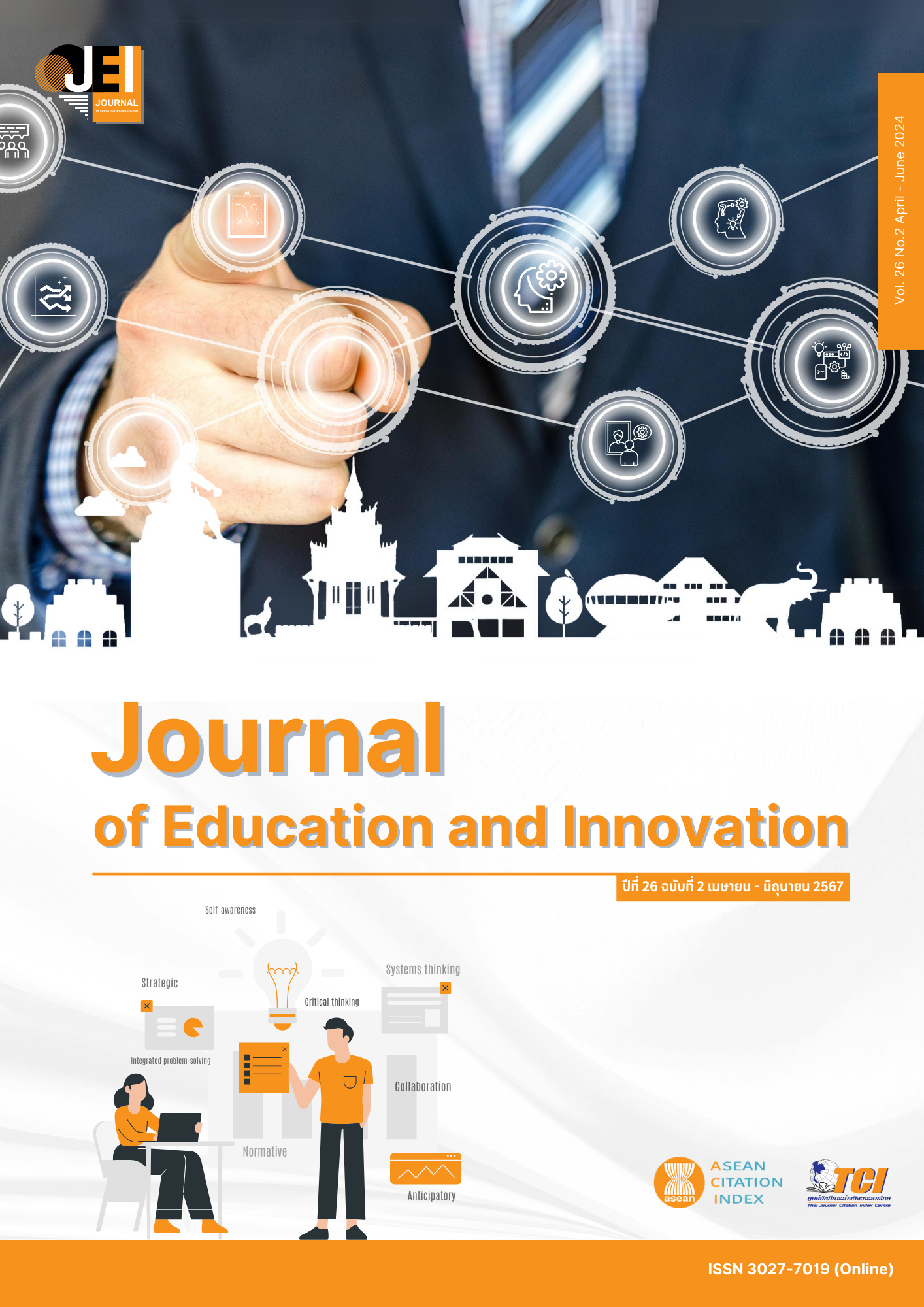ความสามารถในการวาดภาพเพื่อตีความความสัมพันธ์ทางคณิตศาสตร์ของนักเรียนชั้นมัธยมศึกษาปีที่ 5 ที่เรียนรู้ด้วยการจัดการเรียนรู้แบบกรอบความคิด เรื่อง แก๊สและสมบัติของแก๊ส
Main Article Content
บทคัดย่อ
การวิจัยปฏิบัติการในชั้นเรียนนี้มีวัตถุประสงค์เพื่อพัฒนาความสามารถในการวาดภาพเพื่อตีความความสัมพันธ์ทางคณิตศาสตร์ของนักเรียน ด้วยการจัดการเรียนรู้แบบกรอบความคิด เรื่องแก๊สและสมบัติของแก๊ส กลุ่มที่ศึกษาคือ นักเรียนชั้นมัธยมศึกษาปีที่ 5 จำนวน 30 คน เครื่องมือที่ใช้ คือ ใบกิจกรรม แบบสัมภาษณ์กึ่งโครงสร้างวิดีทัศน์บันทึกการจัดการเรียนรู้และแบบบันทึกการสอน นำข้อมูลมาวิเคราะห์ 3 กระบวนการต่อเนื่อง ได้แก่ การวาดภาพระดับอนุภาค การวาดภาพกราฟและการเขียนความสัมพันธ์ทางคณิตศาสตร์ ตรวจสอบข้อมูลแบบสามเส้าด้านวิธีรวบรวมข้อมูล พบว่า 1) การวาดภาพระดับอนุภาค ทุกวงจรนักเรียนวาดภาพที่ประกอบด้วย ทั้ง 4 องค์ประกอบ ได้แก่ การแสดงองค์ประกอบ, การแสดงตำแหน่ง, การแสดงเคลื่อนไหว และการแสดงการมีปฏิสัมพันธ์ภาพ ได้ถูกต้องครบถ้วน 2) การวาดภาพกราฟ วงจรที่ 1, 2, และ 3 นักเรียนวาดภาพกราฟ ได้ถูกต้องแต่ไม่ครบถ้วนทั้ง 3 องค์ประกอบ ได้แก่ การระบุแกน X และ Y, การระบุคู่อันดับและการลากเส้นแนวโน้ม แต่วงจรที่ 4 วาดกราฟได้ถูกต้องครบถ้วนทุกองค์ประกอบ และ 3) การเขียนความสัมพันธ์ทางคณิตศาสตร์ นักเรียนเขียนความสัมพันธ์ด้วยเครื่องหมายคณิตศาสตร์และตัวแปรสอดคล้องกับภาพระดับอนุภาคและภาพกราฟได้ถูกต้องและครบถ้วน 3 รูปแบบ ได้แก่ การแปรผัน ความสัมพันธ์ที่มีค่าคงที่และความสัมพันธ์ระหว่างสองสภาวะ การวิจัยนี้ชี้ให้เห็นว่าการจัดการเรียนรู้แบบกรอบความคิดส่งเสริมให้นักเรียนสามารถอธิบายการเปลี่ยนแปลงของแก๊สและสมบัติของแก๊สด้วยการเชื่อมโยงตัวแทนความคิดทั้งในระดับมหาภาค จุลภาคและสัญลักษณ์ ผ่านการรวบรวมข้อมูลจากปรากฏการณ์ที่สังเกตได้ด้วยตาเปล่า ตีความจากภาพวาดระดับอนุภาคและภาพกราฟ เพื่อสร้างข้อสรุปเกี่ยวกับการเขียนความสัมพันธ์ทางคณิตศาสตร์ได้ดีมากขึ้น
Article Details

This work is licensed under a Creative Commons Attribution-NonCommercial-NoDerivatives 4.0 International License.
เจ้าของบทความมิได้คัดลอก หรือละเมิดลิขสิทธิ์ของผู้ใด หากเกิดการละเมิดลิขสิทธิ์ ไม่ว่าวิธีใด หรือการฟ้องร้องไม่ว่ากรณีใด ๆ ที่อาจเกิดขึ้นได้ กองบรรณาธิการวารสารศึกษาศาสตร์ ไม่มีส่วนเกี่ยวข้องทั้งสิ้น ให้เป็นสิทธิ์ของเจ้าของบทความที่จะดำเนินการ
References
Ainsworth, S., Prain, V., & Tytler, R. (2011). Drawing to learn in science. Science, 333(6046), 1096–1097.
Bain, K., Rodriguez, J. G., Moon, A., & Towns, M. H. (2018). The characterization of cognitive processes involved in chemical kinetics using a blended processing framework. Chemistry Education Research and Practice, 19(2), 617−628.
Busby, B. D. (2018). Transfer of graphing skills from math to chemistry. Montana: The University of Montana Missoula, MT.
Cheng, M. M. W., & Gilbert, J. K. (2017). Modelling students’ visualization of chemical reaction. International Journal of Science Education, 39(9), 1173-1193.
Cole, R., & Shepherd, T. (2019). Making sense of mathematical relationships in physical chemistry. In H.M. Towns, K. Bain and J.M.G. Rodriguez (Eds.). It's just math: research on students' understanding of chemistry and mathematics (pp.143-186). Washington, DC: ACS Symposium Series: American Chemical Society.
Delgado, C. & Lucero M.M. (2015). Scale construction for graphing: an investigation of students’ resources. Journal of Research in Science Teaching, 52(5), 633-658.
Engelbrecht, J., Harding, A., & Potgieter, M. (2005). Undergraduate students’ performance and confidence in procedural and conceptual mathematics. International Journal of Mathematical Education in Science and Technology, 36(7), 701–712.
Fan, J. E. (2015). Drawing to learn: how producing graphical representations enhances scientific thinking. Translational Issues in Psychological Science, 1(2), 170-181.
Gültepe, N. (2016). Reflections on high school students’ graphing skills and their conceptual understanding of drawing chemistry graphs. Educational Sciences: Theory & Practice, 16(1), 53–81.
Ho, F. M., Elmgren, M., Rodriguez, J. M. G., Bain, K. R. & Towns, M. H. (2019). Graphs: working with models at the crossroad between chemistry and mathematics. In Towns, H.M., Bain, K. & Rodriguez, J. M. G. (Eds.). It's just math: research on students' understanding of chemistry and mathematics (pp. 47-67). Washington, DC: ACS Symposium Series: American Chemical Society.
Jantamattukarn, J., Sirisawad, C., & Thongsorn, P. (2019). A comparison of learning achievement and chemistry problem solving skills on “solid liquid and gas” of matthayomsuksa 4 students using 5E inquiry learning cycle model with Polya’s problem solving process and conventional learning management. Journal of Education and Innovation, 21(4), 79–92.
Katz, P. (2017). Drawing for science education. Netherlands: Sense Publishers.
Kulgemeyer, C. & Schecker, H. (2013). Students explaining science—Assessment of science communication competence. Research in Science Education, 43(6), 2235–2256.
Lin, H. & Cheng, H. (2000). The assessment of students and teachers’ understanding of gas laws. Journal of Chemical Education, 77(2), 235-238.
Lin, S.S. & Mintzes, J.J. (2010). Learning argumentation skills through instruction in socioscientific issue: the effect of ability level. International Journal of Science and Mathematics Education, 8(6), 993–1017.
McLure, F. (2019). The Thinking Frames Approach: a case study of inclusion using student-generated multiple-representations. Journal of Research in Special Educational Needs, 20(1), 3-13.
McLure, F. (2022). The thinking frames approach: Improving high school students’ written explanations of phenomena in science. Research in Science Education, 52(1), 1–20.
McLure, F., Won, M. & Treagust, D. F. (2020). Even though it might take me a while, in the end, I understand it’: a longitudinal case study of interactions between a conceptual change strategy and student motivation, interest and confidence. Disciplinary and Interdisciplinary Science Education Research, 2(10), 1-17.
Meela, P., & Artdej, R. (2017). model based inquiry and scientific explanation: promoting meaning-making in classroom. Journal of Education and Innovation, 19(3), 1-15.
Ministry of Education. (2017). Core Learning Indicators and Contents Science Learning Group (Revised 2017) Based on the Basic Education Core Curriculum 2008. Bangkok: Agricultural Cooperative Printing House of Thailand.
Newberry, M., & Gilbert, J. K. (2007). Bringing learners and scientific expertise together. In K.S. Taber (Ed.). Science education for gifted learners (pp. 197–211). London: Routledge.
Park, J., Chang, J., Tang, K. S., Treagust, D. F., & Won, M. (2020). Sequential patterns of students’ drawing in constructing scientific explanations: focusing on the interplay among three levels of pictorial representation. International Journal of Science Education, 42(5), 1–26.
Ploetzner, P., & Fillisch B. (2017). Not the silver bullet: Learner-generated drawings make it difficult to understand broader spatiotemporal structures in complex animations. Learning and Instruction, 47(1), 13-24.
Ryan, S. A. C., & Stief, M. (2019). Drawing for assessing learning outcomes in chemistry. Journal of Chemical Education, 96(9), 1813–1820.
Schuchardt A. M., & Schunn C. D. (2016). Modeling scientific processes with mathematics equations enhances student qualitative conceptual understanding and quantitative problem solving. Science Education, 100(2), 290-320.
Schwarz, C. V., Reiser, B. J., Davis, E. A., Kenyon, L., Acher, A., Fortus, D., Shwartz, Y., Hug, B., & Krajcik, J. (2009). Developing a learning progression for scientific modeling: Making scientific modeling accessible and meaningful for learners. Journal of Research in Science Teaching, 46(6), 632-654. https://doi.org/10.1002/tea.20311.
Secken, N., & Yoruk, N. Z. (2012). An analysis of relation between concerns about the use of graphs in chemistry classes and multiple intelligences in terms of different variables. International Journal of New Trends in Arts, Sports & Science Education, 1(2), 142-156.
Steiner, E. (2008). The chemistry maths book (2nd ed). New York: Oxford University Press.
Taber, K. S. (2013). Revisiting the chemistry triplet: drawing upon the nature of chemical knowledge and the psychology of learning to inform chemistry education. Chemistry Education Research and Practice, 14(1), 156-168.

